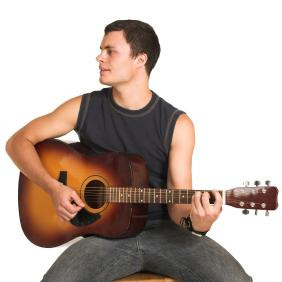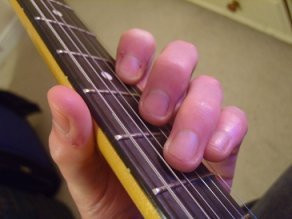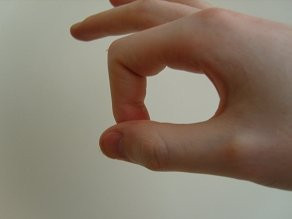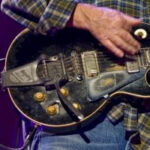It might seem obvious, but understanding how to hold a guitar correctly is the crucial first step for any beginner, even before you start learning chords or strumming patterns. This guide applies to both electric and acoustic guitars. While acoustic guitars tend to be larger, the fundamental holding position remains consistent for both.
If there’s one piece of advice to remember every time you pick up your guitar, it’s this: avoid hunching!
Many guitarists develop a hunching habit, which can negatively impact your posture and potentially lead to back problems later in life. Let’s explore the proper way to hold a guitar while sitting down.
Sitting Comfortably: Perfecting Your Seated Guitar Posture
 Correct sitting posture for guitar playing, man holding acoustic guitar with straight back Correct sitting posture for guitar playing, man holding acoustic guitar with straight back |
A common sitting posture involves having your legs open. For right-handed players (strumming with the right hand), the guitar rests comfortably on the right leg, just below chest level. Notice the guitarist’s straight back and the right angle of his left arm (fret hand arm), minimizing wrist strain when reaching around the fretboard. |
|---|---|
 Comfortable seated guitar position, woman with crossed legs holding guitar with relaxed arm angles Comfortable seated guitar position, woman with crossed legs holding guitar with relaxed arm angles |
Crossing your legs can also be a comfortable option. If you strum with your right arm, cross your right leg. The angle of her left arm is slightly more acute here, which is fine as she can still comfortably reach all strings. The key is to avoid having your fret hand arm at more than a 90-degree angle, as this can cause unnecessary wrist strain. Her strumming arm’s elbow is positioned near the top corner of the guitar, providing a smooth pivot point over the soundhole or first pickup. |
 Slightly tilted electric guitar for better fretboard view, guitarist adjusting guitar angle while seated Slightly tilted electric guitar for better fretboard view, guitarist adjusting guitar angle while seated |
Tilting the guitar slightly towards you can improve your view of the fretboard, especially when you are starting out. While you’ll eventually rely less on looking at the fretboard, this slight tilt is perfectly acceptable for beginners. |
 Ground sitting guitar posture, guitarist sitting cross-legged holding classical guitar with good posture Ground sitting guitar posture, guitarist sitting cross-legged holding classical guitar with good posture |
Sitting on the ground is another option. Again, the leg position is adjusted to ensure the guitar body sits at or just below chest height, minimizing any hunching. The strumming arm maintains the top corner position. |
 Humorous image highlighting good posture despite dangerous location, man playing guitar on railway track with straight back Humorous image highlighting good posture despite dangerous location, man playing guitar on railway track with straight back |
While we don’t recommend sitting on railway tracks, this image humorously illustrates good posture. Notice the straight back! |
Key takeaways for sitting position:
- Whether your legs are crossed or uncrossed, ensure your knees are high enough to support the guitar at chest height or slightly below. This helps maintain good posture and reduces strain.
- Rest the guitar’s waist (the narrowest part of the body) on your lap. For right-handed players, this will be your right lap. This provides a stable base for the instrument.
- The guitar should rest flat against your chest, although a slight tilt towards you is acceptable for better fretboard visibility.
- Consciously avoid hunching your back. Maintain a straight and relaxed posture.
- Position your strumming arm’s elbow towards the top corner of the guitar. This allows your forearm and wrist to pivot smoothly across the strings while supporting the guitar body against you.
- Ensure your fret hand arm is at an angle no greater than 90 degrees. A more acute angle reduces wrist strain when reaching around the fretboard to press down on the strings.
Standing Tall: Holding Your Guitar Upright
If you have a guitar strap, it’s important to practice playing while standing regularly. Standing presents a different playing experience, and if you plan to perform live, you’ll need to be comfortable playing standing up and moving around.
Here are examples of correct and incorrect standing guitar posture:
 Proper standing guitar posture, guitarist with electric guitar and correctly adjusted strap for comfortable playing Proper standing guitar posture, guitarist with electric guitar and correctly adjusted strap for comfortable playing |
This guitarist demonstrates excellent standing posture. Tilting the guitar neck up for better fretboard access is fine and doesn’t compromise other aspects like elbow position. His fret hand elbow is at an acute angle (less than 90 degrees), and his back is straight. The guitar body is at a comfortable height for strumming and picking. His strumming arm’s elbow is forward, aligned with his body, providing a good pivot point. Notice his slightly bent left leg for support, allowing him to lean for a better fretboard view without hunching. |
|---|---|
 Incorrect standing guitar posture, woman with guitar strap too low and hunched back Incorrect standing guitar posture, woman with guitar strap too low and hunched back |
This guitarist demonstrates several common mistakes. The strap is too loose, forcing her to hunch over to reach the guitar. Her fret hand arm is at an obtuse angle (greater than 90 degrees), likely causing wrist strain. Her strumming arm’s elbow is pushed back, hindering a smooth pivot for strumming and picking. This posture is inefficient and potentially harmful. |
Key points for standing position:
- Don’t loosen your strap too much. A guitar that hangs too low (around your knees) makes it difficult to wrap your fingers around the neck to play chords correctly. Functionality trumps looking “cool.”
- Position the guitar so your fret hand arm is at no more than a 90-degree angle for optimal wrist health and playing ability.
- Again, avoid hunching! Maintain a straight back to prevent strain and promote good breathing.
- Ensure your strumming forearm is positioned square-on and angled towards the top corner of your guitar, not behind you. This allows for a smooth and efficient pivot over the strings.
Remember that consistent practice in both sitting and standing positions is crucial, as standing can feel quite different and potentially more challenging initially. However, mastering both prepares you for any playing situation, including performing on stage.
Mastering the Neck Grip: Hand Position for Guitar Neck
Correct hand positioning on the guitar neck is fundamental for playing chords and scales effectively. Incorrect positioning can make playing significantly harder and lead to hand fatigue.
Let’s examine the proper fret hand position from different perspectives:
 Alternative thumb-over guitar neck grip, guitarist with thumb wrapped over the top of the neck Alternative thumb-over guitar neck grip, guitarist with thumb wrapped over the top of the neck |
As you can see, your thumb should rest comfortably on the back of the guitar neck, generally towards the top edge. Your wrist should be relaxed and not excessively low. A slight bend in the wrist is natural and necessary, but avoid extreme bending, which can lead to problems. For players with smaller hands, the thumb might naturally position itself closer to the center of the neck’s back. The initial focus should be on achieving a comfortable and relaxed position. As you learn chords, your fingers will move to various positions, but establishing this comfortable baseline is key. Guitarists with larger hands might find it comfortable to bring their wrist up and slightly wrap their thumb over the top edge of the neck (as shown in the left photo). While comfort is paramount, be aware that this thumb-over technique might require repositioning your thumb to the center for certain chords, demanding more thumb movement overall. |
|---|
Pick Perfection: The Right Way to Hold Your Guitar Pick
The key to Holding A Guitar pick (plectrum) is to avoid gripping it too tightly. It needs to flex smoothly over the strings to produce a good tone and fluid playing.
Holding the pick between the tips of your index finger and thumb achieves the necessary flexibility and control.
| Personally, I like to create an elongated circle like this…  Front view of 'O' shape hand position for holding guitar pick |
Front view of 'O' shape hand position for holding guitar pick |
|—|—|
| With pick in hand, we can see how the straightness of the thumb supports the base of the pick, and the index finger supports more towards the tip of the plectrum.  Front view of guitar pick grip, thumb supporting the pick base and index finger near the tip |
Front view of guitar pick grip, thumb supporting the pick base and index finger near the tip |
Holding your pick in this manner will greatly enhance the smoothness and flexibility of your strumming and picking. It allows the pick to glide over the strings rather than jabbing at them, resulting in a more controlled and musical sound.
Time to Move On…
Hopefully, you now have a solid understanding of how to hold a guitar correctly, eliminating potential basic errors that could hinder your progress. You are now ready to move on to other fundamental guitar skills, such as fingering chords and basic picking techniques.
Remember to dedicate practice time to both standing and sitting positions, as playing standing up can initially feel quite different. However, developing proficiency in both will be invaluable as you progress on your guitar journey and perhaps even envision yourself playing on stage one day!
| Tweet |
|---|
Related Best Way to Hold a Guitar Pick
[

